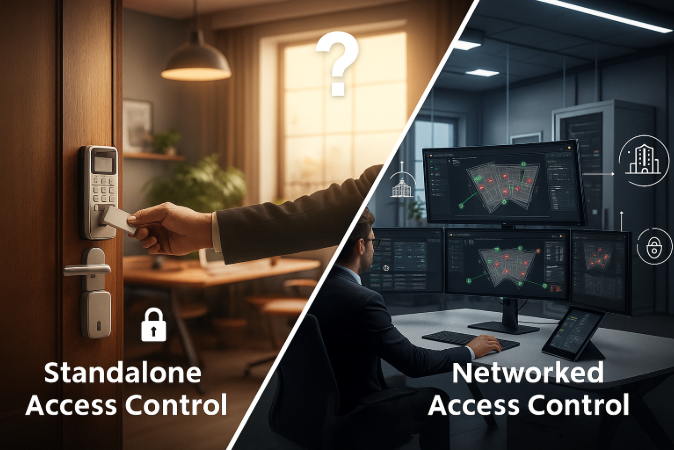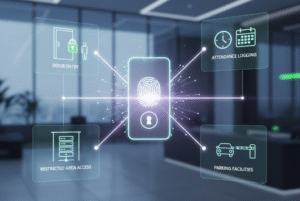Security is no longer a secondary concern for modern businesses – it’s at the core of operations. Choosing the right door access control system for business can determine how efficiently you protect people, assets, and data. The two common options are standalone access control systems and networked (centralized) access management systems. Both have advantages and limitations, and the right choice depends on your business size, structure, and compliance needs.
What Are Standalone and Networked Systems?
Standalone Access Control Systems are independent units installed at each door. They don’t require network connectivity; authorization data is stored and managed locally. This makes them straightforward, budget-friendly, and ideal for businesses with a small number of entry points.
Networked (Centralized) Access Management Systems, on the other hand, connect multiple doors and sites through a central platform. Access rights, reports, and integrations can be managed from one dashboard, making them powerful tools for larger organizations or multi-location offices.
Strengths and Limitations
Standalone Systems
- Cost-effective with lower upfront investment
- Easy to install and manage for a few doors
- Limited scalability and minimal integration options
- Basic logging and compliance features only
Networked Systems
- Scalable across multiple doors, departments, and locations
- Centralized control with detailed reporting and audit trails
- Seamless integration with visitor management systems, CCTV, and alarms
- Higher initial cost but more efficient over time
- Dependent on network and infrastructure reliability
Which System Fits Your Business?
- Small & Medium Enterprises (SMEs): Standalone systems are usually sufficient for single-site businesses with limited staff. They offer security without unnecessary complexity.
- Large Enterprises: With hundreds of employees, multiple access points, and strict compliance requirements, centralized systems are a better fit. They simplify management and ensure consistency.
- Multi-location Offices: For businesses operating across cities or countries, a centralized or cloud-based access management system provides visibility, control, and uniform security policies.
Key Factors to Consider
When evaluating building access systems or commercial building access control systems, decision-makers should weigh:
- Number of users and doors – large volumes require centralized management
- Integration needs – visitor management, video surveillance, or alarm systems
- Compliance requirements – industries with strict regulations need audit-ready systems
- Budget and long-term value – upfront savings vs. scalability and efficiency over time
- Future growth – choose a system that can evolve with your business
Why Smart i Electronics Systems?
At Smart i Electronics Systems, we understand that every business has unique security challenges. That’s why we offer both standalone door access control systems and centralized access management systems designed to scale with your growth.
- SMEs can benefit from our cost-effective standalone solutions.
- Large enterprises and multi-site organizations can rely on our centralized platforms, built for seamless integration and compliance.
- Our systems are future-ready, allowing businesses to upgrade without replacing the entire setup.
Whether you’re protecting a small office or managing complex, multi-site operations, Smart i provides secure, reliable, and customizable office access control systems.
Conclusion
Both standalone and networked systems have their place in modern security strategies. The best choice depends on your scale, compliance needs, and future plans. For small offices, standalone systems may be adequate. For larger or expanding businesses, centralized access management offers long-term efficiency, integration, and control.
If you’re uncertain which path is right, Smart i Electronics Systems can guide you toward the most effective solution – ensuring your business is both secure today and ready for tomorrow.





